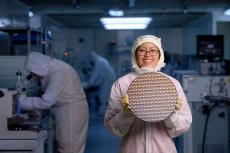150 National Leaders Gather at UA to Map the Future of Semiconductors
About 150 national leaders from higher education, government, nonprofits and industry gathered at a conference sponsored by the University of Arizona’s Center for Semiconductor Manufacturing on Feb. 19 and 20 to strategize around how to shore up the domestic semiconductor industry.
Advancements in semiconductor technologies are indispensable to today’s standard of living. Smart phones, cameras, autonomous vehicles, health care devices and homeland security, for example, all rely on computer chips.
“Applications are exploding with every new generation of semiconductors as they become more and more specialized for particular needs and get smaller and smaller,” said Liesl Folks, director of the Center for Semiconductor Manufacturing, which provides regional industry with expertise in manufacturing processes.
Participants at the first FuseNano Future of Semiconductors conference not only tackled the need for technological advancements but also discussed partnerships to improve educational outreach and workforce development.
“This is a great platform to bring together all the people specializing in semiconductors,” said Zafer Mutlu, the event’s organizer and an assistant professor of materials science and engineering and electrical and computer engineering. “The discussion is giving a roadmap to all aspects of the field.”
A Time of Growth and Potential
The 2022 Chips and Science Act, passed after the shortages of the COVID-19 pandemic, ensures federal investments in industry to increase the nation’s global share. Some states, including Arizona, are also investing heavily in their semiconductor industries. The Arizona Commerce Authority committed $100 million statewide in November 2022, including $35.5 million, announced in November 2023, for the UA College of Engineering cleanroom facility expansion and workforce development.
“This moment is particularly important because universities are being called on to play a much stronger role in helping the U.S. semiconductor sector become more effective and efficient in manufacturing, not just in the design and development of new materials,” said Folks, adding that the manufacturing process and global distribution channels are complex.
“We want to make sure every piece of that value chain is more resilient than it is today.”
These relationships also enrich education, said keynote speaker Todd Younkin, president and CEO of Semiconductor Research Corp. “The University of Arizona is uniquely positioned due to its connections with local semiconductor titans to instill and refine specific knowledge, skills and abilities,” he said.
Focusing on the People
While the U.S. is maintaining the lead in global market share, according to the Semiconductor Industry Association, manufacturers are facing a significant workforce shortage.
“If we just develop the technology and don’t focus on the people, that’s a loss,” said Younkin.
The association projects 33% growth in today’s approximately 345,000 semiconductor-related jobs by 2030, with 58% at risk of going unfilled. Positions range from technicians to engineers and jobs requiring doctoral degrees.
Arizona, which exported $4.2 billion in semiconductors in 2022, already is experiencing an acute shortage of workers in the state’s fast-growing computer chips industry, said Folks, also the university’s vice president for semiconductor strategy and professor of electrical and computer engineering.
Panelists included Patricia Simmons, associate program director for the Division of Engineering Education and Centers at the National Science Foundation, and Erik Hadland, director of technology policy with the Semiconductor Industry Association. They discussed the merits of undergraduate research, apprenticeships, and nationwide programs, such as knowledge content repositories.
From the state perspective, Folks highlighted UA’s partnerships with Northern Arizona University, Central Arizona College, Pima Community College and Chandler Unified School Districts, stressing how workforce development depends on educational institutions working together.
The university and its partners, with support from the Arizona Commerce Authority, are establishing platforms for sharing curriculum digitally and augmented reality training. Additionally, UA is developing training for high school teachers and laying the groundwork for undergraduate and graduate degree programs in semiconductor manufacturing.
“Academic institutions across the state are coming together and pulling in a common direction to ensure a bright future for Arizona’s economic development and semiconductor workforce,” said Folks.




